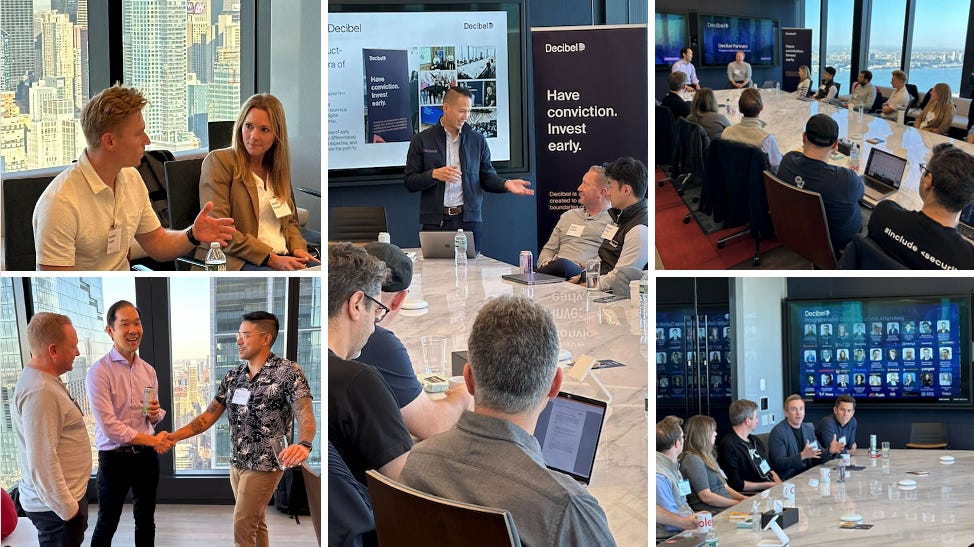Programmable Defense Summit: A Recap
The Path to an Autonomous Defense Begins with Programmability
We recently hosted the inaugural Programmable Defense Summit in New York City, bringing together some of the most forward-thinking cybersecurity leaders and founders. The discussions centered on how the security industry is shifting toward a more transparent, adaptable, and customer-centric, rather than vendor-centric, security posture.
This blog offers a quick recap of both the summit and the investment thesis that inspired it, along with key trends shaping the future of programmable defense. Throughout, we’ll share some of the most thought-provoking quotes from the day—anonymized but too good not to highlight.
A special thank you to the incredible CISOs and security leaders in attendance, including those from Prudential, BNY Mellon, Cribl, Ro, Vanta, Workato, Crowdstrike, Maven Clinic, FanDuel, and Dropbox whose insights helped make this such a dynamic and impactful event.
Security Secular Trends
"Programmable defense puts power back in the hands of security engineers—moving fast is no longer a luxury but a necessity."
The security landscape is shifting rapidly, driven by both technological advances and evolving threat vectors:
AI-Enhanced Threat Actors:
Threat actors are leveraging AI to scale their operations. Tools like ChatGPT make it possible for attackers to generate convincing phishing emails or automate reconnaissance. The barrier to entry for orchestrating complex cyberattacks has plummeted, resulting in a significant uptick in both volume and variety of threats.A New Generation of Security Leaders:
Today’s security teams have grown up in a world shaped by DEFCON and Black Hat conferences. These leaders are now reaching the C-suite, bringing with them expectations of in-house security engineering expertise. Unlike in previous eras, relying security purely on product vendors is no longer the default—security leadership expects its own sophisticated operations to be able to collaborate with the vendor in the the product.Collaborative Defense Communities:
Security professionals are organizing on platforms like X and Mastodon to share intelligence and counter common threats. Much like the 1% of social media users who create content consumed by the 99%, a small but growing group of defenders is publishing actionable insights for broader community benefit.
From Click-Ops to Programmable Security
"The black box might scale, but it doesn’t solve enough problems. The future is transparent and programmable."
Security tooling is evolving, and a fundamental shift is underway:
The Demand for Transparency:
Black-box solutions are increasingly seen as insufficient for modern security challenges. Instead, forward-thinking organizations expect their tools to be programmable, consumable via APIs, and tailored to their unique environments and needs of an organization.Parallels with DevOps:
Just as open-source software and agile DevOps tooling empowered developers, programmable security will unleash creativity and innovation within security teams. Leaders envision a future where security engineers can adapt tools in real time, fostering collaboration and sharing knowledge across organizations.
Programmable Defense: A Foundation for the Autonomous Defense
"LLMs are the bridge—making security decisions understandable to executives and actionable for engineers."
The Autonomous Defense: Programmable defense is the cornerstone of a future autonomous cybersecurity ecosystem, as effective AI requires vast amounts of high-quality first-party data. By enabling security experts to contribute directly to the system, programmable defense becomes a powerful, community-driven engine for defense—one capable of evolving in a rapidly changing adversarial environment. However, implementing this strategy today is not without challenges. It demands deep technical expertise, including an understanding of code and detection engineering, skills that not all security teams possess. This gap often limits organizations’ ability to operationalize programmable tools effectively.
Sublime Security, utilizes BERT LLM, enhances Sublime's Natural Language Understanding and brings improved contextual awareness and understanding, language comprehension, and performance to better identify GenAI in phishing attacks.
Enter AI: LLMs democratize access to sophisticated defense strategies by translating complex, technical threat intelligence into actionable steps that engineers can implement and executives can understand. This collaboration between AI and humans is a critical step toward autonomous defense—where systems can dynamically adapt to threats in real time, powered by first-party data collected from real attacks and responses from a community fighting a common enemy.
Programmable defense is as much about culture as technology, relying on transparency, collaboration, and shared knowledge. AI makes this vision achievable, enabling adaptive, ever-improving cybersecurity systems for the future.
Looking Ahead
The discussions at the Programmable Defense Summit confirmed what many of us already believed: In order to build a truly dynamic autonomous defense that can keep pace with the high variety and volume of attacks of the future, cybersecurity products first have to become more programmable, transparent, and collaborative. While we’re still early in this journey, the momentum is exciting.
To those who attended and contributed to this pivotal conversation—thank you. If you are interested in joining us for the next event, please reach out!








This will be the dominant thesis for security going forward and I'm excited to continue seeing the community get together to discuss and push the industry! Awesome write-up.
This was a phenomenal event! Great write up, can’t wait for the next one!